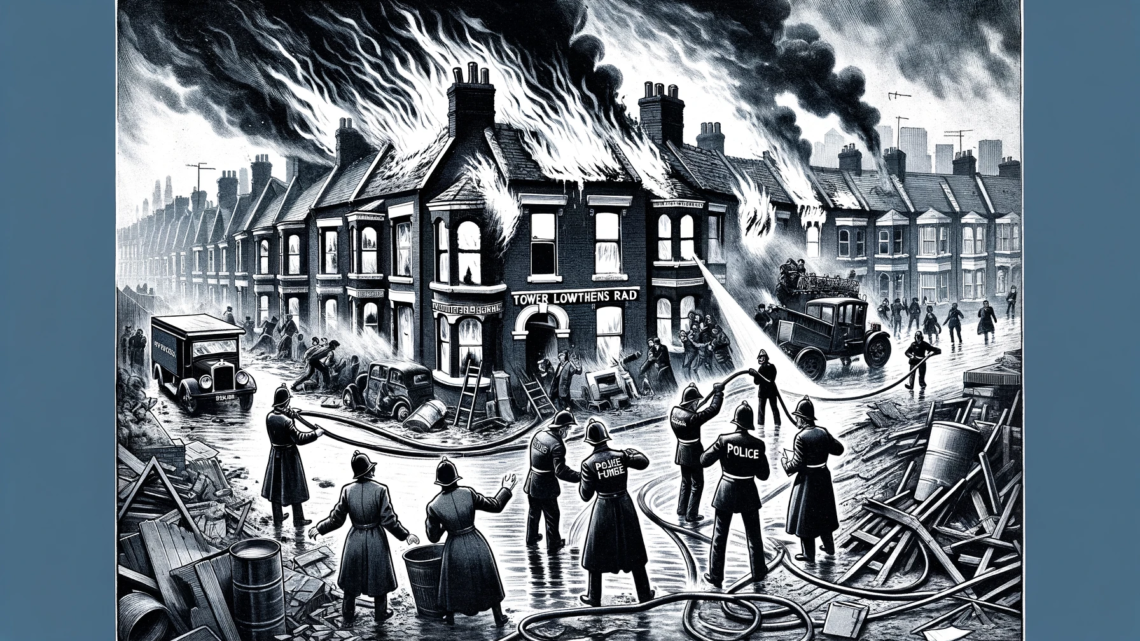Four Houses Destroyed.

Great Fire at Tower Hamlets.
On Tuesday just at noon a most destructive fire broke out at 45 Lowther Road Tower Hamlets causing the entire destruction of the of the interior of four houses and a good deal of damage to five others. Lowther Road is a row of new houses on the site of the old brickfield, and only one side of the road is built on the greater part of the road, the houses facing the Fever Hospital. No. 45 where the fire broke out is a small general shop occupied by Mrs Critch a widow and her four children.
It seems that shortly before 12 one of the children either took some fire into the coal cellar, which is really a cupboard under the stairs or lit some matches in it and set the place on fire. Mrs Critch saw the flames rush out of the door and made an attempt to put it out, but the place being all wood the flames spread with great rapidity. Her screams brought the neighbours to her assistance but nothing could be done and the house had to be abandoned practically nothing being saved.
A lad named Hadlow was at once sent to the Police Station for assistance arriving there at 12-10. Inspector Baker who was in charge of the Station at once sent the hose reel from the Town Hall to the fire in charge of P.C. Mount and Holmes whilst information was also given to the Surveyor’s Department in order to obtain the high pressure supply of water to the district it being ordinarily supplied from the low service reservoir. When the hose reel arrived at the Tower Hamlets turning in High Street a body of youths were waiting to drag it up the hill and they raced it up to the scene of the fire in a remarkably short time. On arriving at the spot they found No. 45 entirely in flames, which were spreading to the adjoining houses.
The standpipe was at once fixed and a supply of water obtained. It was feeble in force but in less than a minute after it had been turned on the high-pressure service was put on to the district and a good supply of water obtained. This proved useless in stopping the fire. The houses are not very stoutly constructed there being a large quantity of wood in them whilst the roofs from 41 to 56 are continuous and the fire getting into the rafters along from house to house-in great rapidity. It is needless to say there was tremendous excitement. It being dinnertime and the men home from work their was ample assistance.
A Whole Street Turn Out Their Furniture.
The furniture of the adjoining houses was at once brought out into the street whilst others under the direction of the Police Fire Brigade who were quickly arriving in great force, one party being brought up at a gallop in Messrs. Pilcher and Chittenden’s cart and another lot in a cab set to work to pull away the tiles of the roof of No. 51 to stop the flames running along and also to enable the hose to be played on to the flames as they worked along. At No. 55 the roof was entirely cut in two but the fire happily did not reach as far as this.
The adjoining houses 41, 43, and 45 the numbers running odds consecutively however were soon in flames and nothing could be done to save them. The furniture except in the upper rooms of 43 was however to a great extent saved. Although the flames spread with great rapidity and involved these four houses as well as the roof of 49 and 51 the fire did not last long for in a little over half an hour from the outbreak the flames themselves were subdued and only the smoking and smouldering ruins remained on fire. The inhabitants had by this time removed their furniture from the houses as far along as No. 63 and for some distance on the other side. This placed the street that is not yet taken over by the Corporation and is in frightful condition. The furniture in the utmost confusion lying in a mass of mud and on the banks of the opposite side of the road with the huge crowd attracted by the outbreak formed a scene never before seen in Dover.
At No. 61 a very sad duty had to be performed. The previous night a little baby had died very suddenly and when the house stood in danger of being involved in the outbreak the body was removed to the King Edward V11. Public House. At 1-45 the Police reported the fire to have been completely extinguished. Fortunately no one was burnt or seriously injured. One or two people in the rush and excitement sustained cuts and contusions but they were not of a serious nature. Later in the day the inhabitants of the adjoining houses who had turned out all their worldly possessions in this short hasty fashion into the street had to occupy themselves in removing them back where the houses were inhabitable.
Four houses 41, 43, 45 and 47 were destroyed. 49 and 51 were damaged so as to be practicably uninhabitable, whilst at 55 the roof had been nearly all removed in order to stop the fire. 53 and 57 were also damaged. The occupier of 43 left in the front bedroom of which was burnt a considerable sum of money. As soon as the fire was extinguished he at once set to search for it in the ruins and found the greater portion. Four of the houses 43, 45, 47, and 49 were offered for sale by action at the Metropole Hotel on October 27th but were not sold. They were all built quite recently.
January 1904.